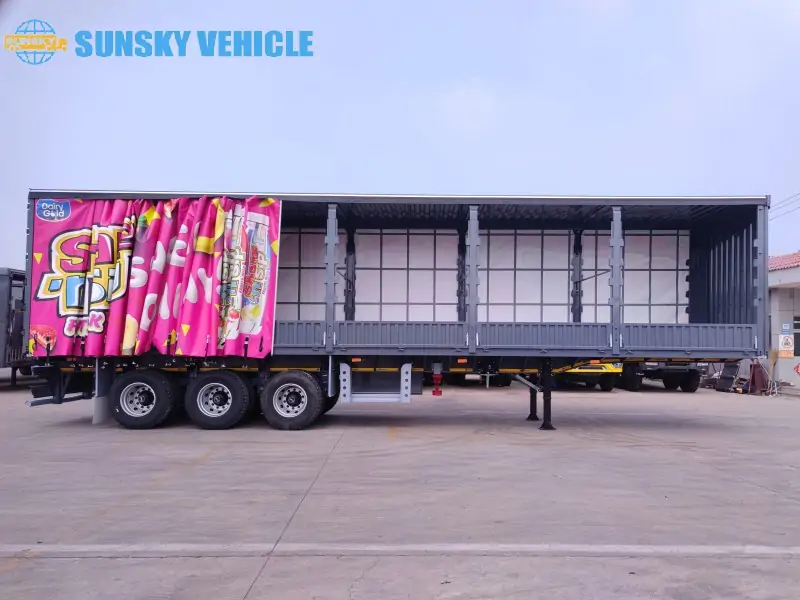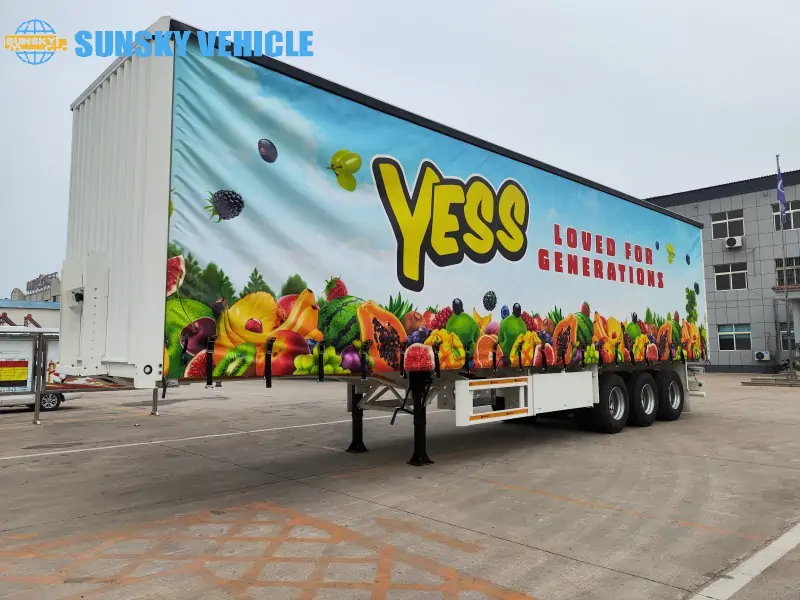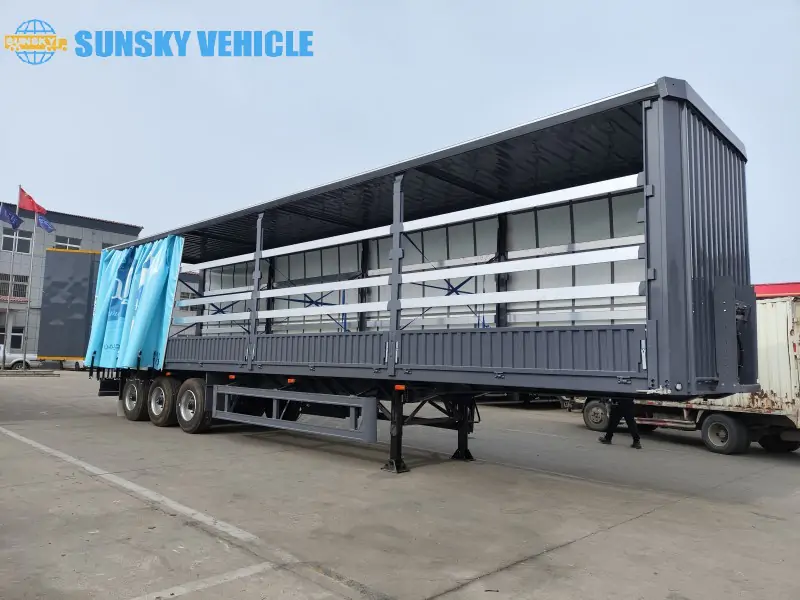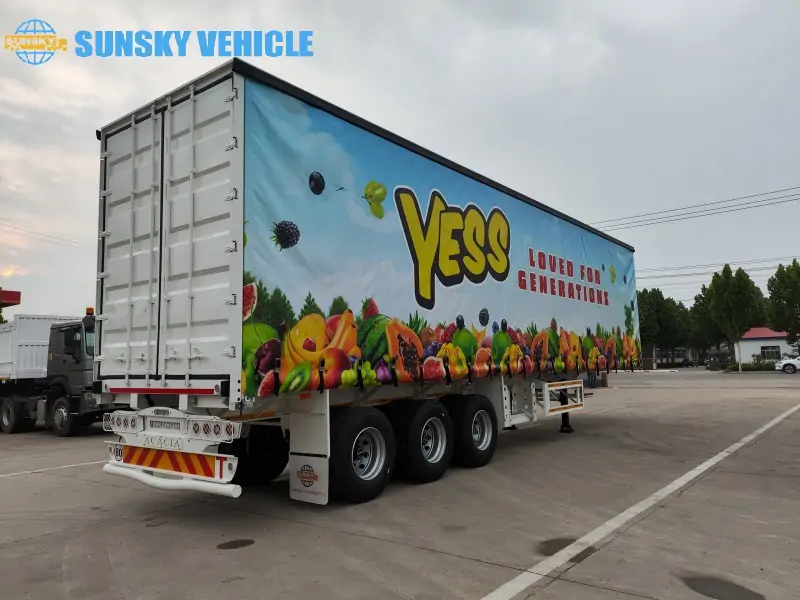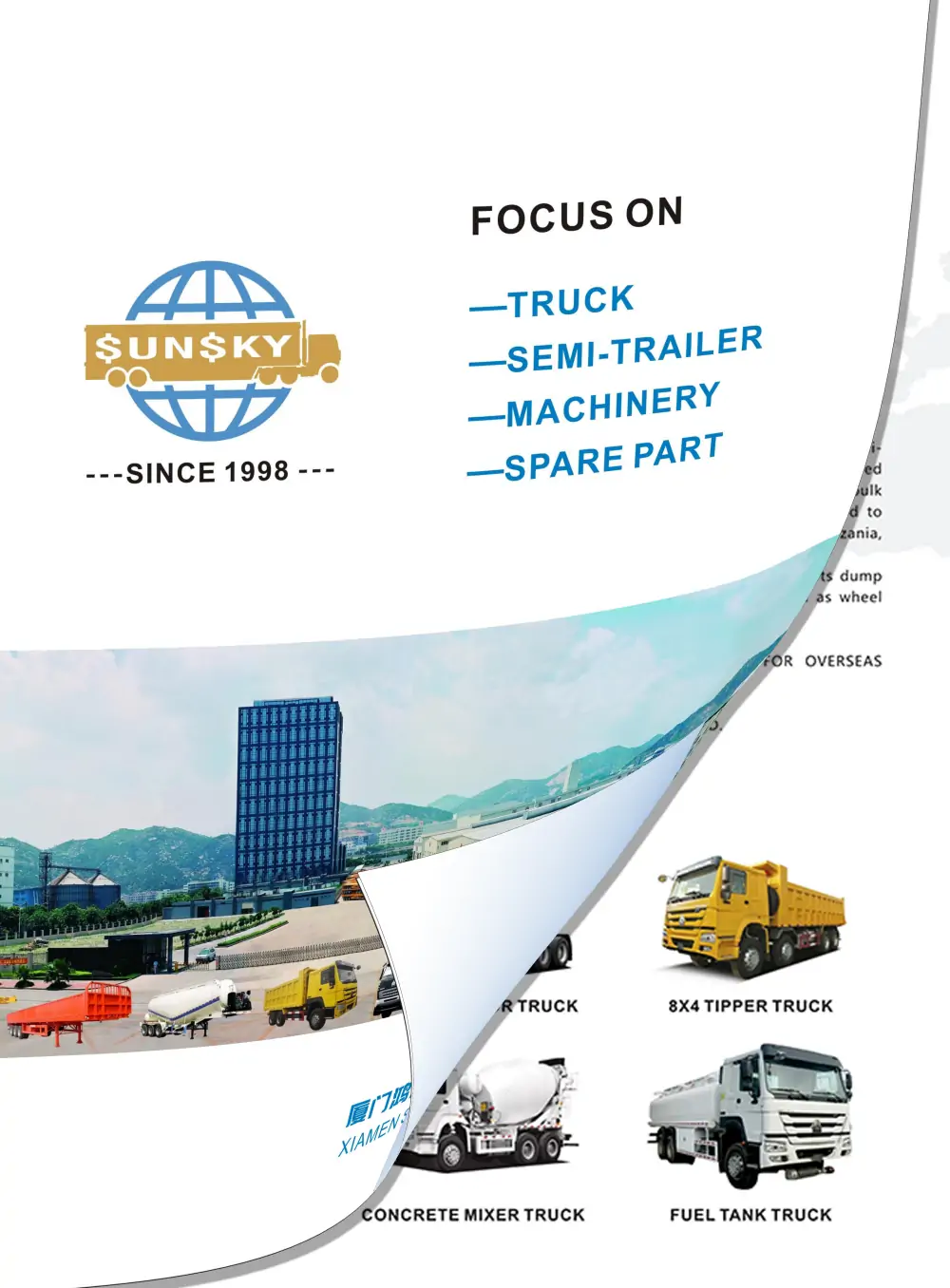In the world of logistics and freight transportation, efficiency and flexibility are everything. Among the many types of trailers used to move goods, the curtain side trailer—also known as a curtainsider or tautliner—stands out for its unique combination of protection, accessibility, and speed.
A curtain side trailer is designed with flexible curtains along its sides that can be pulled back like drapes, allowing for quick side loading and unloading of cargo. This makes it ideal for businesses that need to transport palletized goods, large machinery, or products that must be loaded by forklift from the side rather than the rear.
Understanding what a curtain side trailer is, how it works, and why it’s favored by many logistics operators can help fleet owners, importers, and exporters choose the right vehicle for their transportation needs. Whether you’re managing regional deliveries or cross-border shipments, this trailer type offers a balance between speed, safety, and versatility—key factors in modern supply chain efficiency.
Definition & Key Features of Curtain Side Trailers
A curtain side trailer is a type of semi-trailer built to provide both protection from the elements and quick access to cargo. Its design combines the structural strength of a flatbed with the enclosure of a dry van, offering the best of both worlds for modern logistics and transport operations.
What Defines a Curtain Side Trailer
At its core, a curtain side trailer consists of a rigid roof and rear doors, while the sides are made of retractable PVC curtains that slide along runners. These curtains are tensioned by buckles or straps to create a tight, weather-resistant seal around the cargo area.
When loading or unloading, operators can simply release the curtain tension and pull the curtain back to expose the full length of the trailer. This side-loading capability is one of the key advantages—it allows forklifts or cranes to access cargo quickly without needing to open rear doors or maneuver in tight spaces.
Many modern curtain side trailers are equipped with aluminum side posts, sliding roofs, or movable bulkheads to further improve flexibility and structural integrity. The typical construction materials include galvanized steel frames and high-tensile fabric curtains, ensuring durability even in demanding transport conditions.
In short, a curtain side trailer is defined by:
-
A fixed roof and chassis for stability
-
Sliding curtains on both sides for fast access
-
Rear doors for secure closure
-
Lightweight yet durable materials for high payload capacity
This design not only speeds up the loading process but also helps maintain cargo protection against rain, wind, and dust—critical factors in long-distance and regional freight.
Curtain Side Trailer vs. Other Trailer Types
To fully understand the benefits of a curtain side trailer, it helps to compare it with other common trailer types used in freight transport:
-
Dry Van Trailer:
A dry van is a fully enclosed trailer with solid metal walls and rear-only loading. It provides excellent cargo protection but limited access, requiring all loading to occur from the back. In contrast, a curtain side trailer offers the same protection plus side access, making it more versatile for mixed or palletized freight. -
Flatbed Trailer:
A flatbed is an open trailer without sides or a roof, perfect for oversized or irregular cargo. However, it leaves freight exposed to weather and requires tarping for protection. A curtain side trailer solves this by combining flatbed loading flexibility with built-in weather shielding, reducing manual labor and risk. -
Conestoga Trailer:
Often seen as a hybrid between a flatbed and curtain side, the Conestoga features a rolling tarp system on a sliding frame. While similar in concept, the curtain side trailer uses side-opening curtains instead of a retractable top, offering faster side access and simpler maintenance.
Overall, the curtain side trailer delivers a balanced mix of protection, accessibility, and efficiency, making it a preferred choice across industries such as manufacturing, retail distribution, and import/export logistics.
Types of Curtain Side Trailers
Curtain side trailers come in several variations, each designed to meet specific operational needs. While all share the same fundamental structure—rigid frame, flexible side curtains, and quick loading access—the differences lie in roof design, deck configuration, and curtain tensioning systems. Understanding these types helps logistics managers and fleet owners select the best model for their transport requirements.
Standard Curtain Side
The standard curtain side trailer is the most common configuration. It features a single, flat load deck, fixed roof, and full-length retractable curtains on both sides. The design prioritizes versatility and is suitable for palletized cargo, building materials, retail goods, and general freight.
These trailers typically measure 13.6 meters (45 feet) in length with a payload capacity of up to 26 tons, depending on regional regulations. They can be loaded or unloaded from either side or the rear, making them an ideal all-round solution for companies that handle multiple types of cargo on tight delivery schedules.
In essence, the standard curtain side offers a perfect balance of protection, capacity, and ease of access, making it a favorite across European and international road transport fleets.
Tautliner (Tensioned Curtain)
The tautliner is a variation of the standard curtain side trailer, originally developed by Boalloy in the UK. Its key feature is the tensioning system—the side curtains are pulled tight both vertically and horizontally, creating a flat, aerodynamic surface when closed.
This design minimizes wind resistance during travel and provides better weatherproofing and cargo security. The tautliner’s curtain tension is maintained by ratchets or levers, ensuring that the side fabric remains tight even after repeated use.
Because of its strength and sealing efficiency, the tautliner is widely used for long-haul logistics, FMCG distribution, and time-sensitive shipments. Many people use “tautliner” interchangeably with “curtain side trailer,” though technically, all tautliners are curtain siders, but not all curtain siders are tautliners.
Euroliner (Retractable Roof)
The Euroliner trailer introduces another layer of flexibility with its retractable roof system. In addition to the side curtains, the roof can be slid open or partially retracted to allow top loading by crane or hoist.
This makes the Euroliner particularly valuable in industries such as steel manufacturing, timber transport, and construction logistics, where bulky goods must be loaded from above.
The retractable roof is supported by lightweight aluminum rails and rollers, ensuring smooth operation and maintaining the trailer’s weatherproof seal when closed. The Euroliner thus bridges the gap between a curtain side trailer and an open flatbed, combining both top and side loading options for maximum efficiency.
Double-Deck / Other Regional Variations
The double-deck curtain side trailer is designed for operators needing maximum volume utilization. It features an additional internal deck—either fixed or adjustable—allowing the trailer to carry two levels of palletized goods. This configuration can increase capacity by up to 60%, making it ideal for retail distribution and high-volume logistics.
Regional variations also exist to meet local regulations and cargo requirements. For example:
-
In Europe, shorter wheelbases and height limits lead to compact “mega-curtain” models with 3-meter internal height.
-
In Asia and the Middle East, reinforced chassis and heavy-duty suspension systems are common due to rougher road conditions.
-
In Africa, side-curtain trailers often feature steel side rails or reinforced curtain materials to handle harsh climates and long-distance hauls.
Whether it’s a standard, tautliner, Euroliner, or double-deck design, each curtain side trailer type is built to improve loading efficiency, cargo protection, and fleet productivity—key priorities in the competitive logistics industry.
Dimensions, Capacity & Regional Specifications
When choosing a curtain side trailer, understanding its dimensions and load capacity is essential for ensuring compliance with transport regulations and maximizing operational efficiency. While the basic design remains consistent worldwide, size standards and payload limits vary across different regions such as the United States, Europe, and Asia.
Below is an overview of the most common curtain side trailer specifications and how they differ globally.
Typical Sizes in the United States
In the U.S. market, curtain side trailers are often built to match the country’s long-haul freight requirements and highway regulations. The standard specifications include:
-
Length: 48 ft or 53 ft (14.6 m – 16.1 m)
-
Width: 102 inches (2.6 m)
-
Internal Height: 110–114 inches (2.8–2.9 m)
-
Tare Weight: Approximately 15,000–17,000 lbs (6,800–7,700 kg)
-
Payload Capacity: Up to 45,000 lbs (20,400 kg)
U.S.-style curtain side trailers are typically used for general freight, industrial equipment, construction materials, and manufactured goods that need protection from the weather but still require easy side access.
Some operators opt for Conestoga-style curtain systems, which comply with DOT regulations while providing flexibility for irregular or heavy cargo. The overall goal in the American market is to maximize cube utilization while maintaining stability at high speeds on interstate routes.
Typical Sizes in Europe / Middle East / Southeast Asia Markets
In Europe, the 13.6-meter curtain side trailer is the standard configuration—often called a “Tautliner” or “Euroliner.” European road laws prioritize maneuverability and axle weight limits, resulting in slightly more compact yet highly efficient designs:
-
Length: 13.6 m (approx. 45 ft)
-
Width: 2.5 m
-
Internal Height: 2.7–3.0 m (depending on variant)
-
Payload Capacity: 24–26 tons
These trailers are common across continental freight corridors, often seen in cross-border transport between the UK, Germany, France, and Eastern Europe.
In the Middle East, curtain side trailers are often reinforced for heat resistance, with stronger PVC side curtains and heavy-duty axles to withstand desert conditions and long hauls. Standard lengths range from 12–14 meters, with payload capacities up to 30 tons.
In Southeast Asia (SEA), manufacturers adapt designs to local regulations and road conditions. You’ll find 12-meter trailers commonly used for port logistics, containerized goods, and regional deliveries. Lightweight steel or aluminum frames are preferred to reduce fuel consumption and improve maneuverability in congested cities.
Overall, these regional adaptations demonstrate how the curtain side trailer remains a globally versatile platform, adaptable to various road infrastructures and cargo demands.
How to Interpret These Specs When Comparing Models
When comparing curtain side trailer models across regions, several key factors should guide your evaluation:
-
Regulatory Compliance:
Check local transport authority rules on maximum vehicle length, axle load limits, and overall height. A trailer suitable for Europe may exceed height limits in parts of Asia or Africa. -
Cargo Type and Weight:
Match the payload capacity to your cargo’s average weight. Heavy industrial or construction goods may require reinforced chassis and axles, while FMCG and retail logistics prioritize lighter frames and higher internal volume. -
Operational Environment:
Consider weather conditions and road quality. For example, high-humidity or desert climates require UV-resistant curtain materials and anti-corrosion chassis coatings. -
Accessibility and Equipment Compatibility:
Evaluate whether you need side, rear, or top loading access, especially if your warehouse setup uses cranes, forklifts, or pallet jacks. -
Maintenance and Lifecycle Costs:
Simpler curtain mechanisms may lower maintenance costs, while advanced tensioning systems (like tautliners) offer better sealing but require more frequent adjustment.
Understanding these specifications allows fleet managers, logistics planners, and buyers to make informed decisions—ensuring their chosen curtain side trailer model not only meets local compliance but also delivers maximum efficiency, safety, and return on investment.
Robust and Durable, Achieve Exceptional Transport Start your project today and get a high-performance semi-trailer solution tailored specifically to your unique needs.
Uses &
Applications of Curtain Side Trailers
The curtain side trailer is one of the most versatile transport solutions in the logistics industry. Its unique design—combining full weather protection with quick side-loading access—makes it suitable for a wide range of industries and cargo types. From large-scale retail distribution to construction supply chains, this trailer type helps businesses move goods faster, safer, and with greater flexibility.
Which Industries Benefit
-
Retail & Fast-Moving Consumer Goods (FMCG)
Retail logistics depend heavily on efficiency and timing. Curtain side trailers are widely used to transport palletized goods, packaged food, and household products between distribution centers and retail outlets. The ability to load and unload from either side allows for faster dock turnover, which is crucial in high-volume retail supply chains. -
Manufacturing & Industrial Equipment
Manufacturers often ship heavy machinery, components, and finished products that require protection from rain and dust during transport. Curtain side trailers provide the structural strength of a flatbed while maintaining an enclosed space, making them ideal for automotive parts, metal fabrication, and assembly materials. -
Construction & Raw Materials
Building sites frequently receive materials such as timber, steel pipes, cement bags, or insulation panels, which are bulky but not always weatherproof. Curtain side trailers enable easy side forklift access, so loads can be delivered directly to specific site zones without needing cranes or rear-loading docks. -
Agriculture & Perishables
While not refrigerated, curtain side trailers can transport fresh produce, grains, and packaged agricultural goods that require air circulation and protection from direct sunlight. For short- to medium-distance routes, they serve as a cost-effective alternative to fully insulated or reefer trailers. -
Freight Forwarding & Cross-Border Logistics
Freight forwarders often choose curtain side trailers for mixed loads and transit flexibility. Their compatibility with palletized, boxed, or irregular cargo makes them a go-to choice for cross-border trade where loading conditions vary from one warehouse to another.
In essence, any business that values fast access, load protection, and operational efficiency can benefit from using a curtain side trailer in its logistics network.
Why Use Side-Loading / Unloading Advantages
The main advantage of the curtain side trailer lies in its side-loading capability, a feature that revolutionizes how freight is handled. Traditional dry vans restrict access to the rear, forcing operators to use loading docks and specific equipment. Curtain side trailers eliminate this limitation entirely.
Here’s why side loading and unloading is such a game changer:
-
Faster Loading Times:
The entire side of the trailer can be opened within minutes, allowing multiple forklifts to work simultaneously. This dramatically cuts down loading and unloading time compared to rear-only access. -
Greater Accessibility in Tight Spaces:
In many distribution centers, factories, or urban delivery zones, rear access can be restricted. With curtain side trailers, goods can be loaded even in narrow yards or roadside conditions where docking bays are unavailable. -
Improved Safety and Ergonomics:
Workers can load cargo directly from the side without climbing into the trailer, reducing the risk of injury and minimizing manual handling. -
Versatility for Different Cargo Shapes:
Oversized or irregular goods—such as pipes, lumber, or machinery—can be positioned easily from the side. This flexibility reduces the need for cranes or complex lifting systems. -
Reduced Downtime:
Because loading isn’t limited to specific bays or equipment, trucks spend less time idling and more time on the road, improving fleet productivity and fuel efficiency.
In short, side-loading capability gives the curtain side trailer a distinct operational edge. It not only enhances speed and accessibility but also contributes directly to lower logistics costs and improved turnaround times—key factors for any company looking to stay competitive in today’s fast-paced supply chain environment.
Advantages & Disadvantages of Curtain Side Trailers
Like any trailer type, the curtain side trailer comes with its own set of benefits and trade-offs. Its popularity in logistics is driven by its unique combination of speed, accessibility, and cargo protection, but certain limitations—such as cost and structural weight—also need to be considered before purchasing or deploying one across a fleet.
Advantages
-
Faster Loading and Unloading
The primary advantage of a curtain side trailer is efficiency. The side curtains can be opened fully in seconds, enabling multiple forklifts to load or unload cargo simultaneously. This reduces dock time, improves vehicle turnaround, and boosts daily delivery capacity. -
Superior Accessibility
Curtain side trailers allow complete side access, making them ideal for operations without standard loading docks. Drivers can deliver or collect goods in confined areas—such as construction sites, warehouses, or retail parks—where traditional dry vans struggle. -
Excellent Weather and Cargo Protection
Despite their open-sided design, these trailers are built with heavy-duty PVC curtains, offering protection against rain, dust, and UV exposure. When properly tensioned, the curtains form a sealed barrier that keeps cargo safe even over long distances. -
Increased Load Visibility and Inspection Ease
Logistics teams can easily check the cargo condition by partially opening the side curtains, without needing to climb inside or unpack the trailer. This improves operational visibility and quality control. -
Versatility for Multiple Cargo Types
Whether transporting palletized goods, building materials, or machinery, curtain side trailers accommodate a wide range of cargo shapes and sizes. This flexibility reduces the need for multiple trailer types across a mixed fleet. -
Professional Appearance and Branding Potential
Many operators use the curtain panels as advertising space, displaying logos or brand messages. This transforms the trailer into a moving billboard, offering additional marketing value during transit.
Disadvantages
-
Higher Initial Cost
Compared to standard flatbeds or dry vans, curtain side trailers are generally more expensive due to their specialized structure and tensioning system. The additional components—sliding rails, buckles, and reinforced curtains—add to the upfront investment. -
Heavier Overall Weight
The curtain mechanism and supporting framework increase the trailer’s tare weight, slightly reducing payload capacity compared to equivalent flatbeds. For fleets focused on maximum tonnage, this trade-off can affect fuel efficiency and profitability. -
Limited Overhead Loading Options
While the side curtains provide excellent lateral access, top-loading via crane is not possible unless the trailer has a retractable roof (as in the Euroliner design). This may restrict its use for certain heavy or irregularly shaped cargo that requires overhead lifting. -
Maintenance and Curtain Wear
The tensioning straps, buckles, and curtain fabric require periodic inspection and maintenance. Frequent use, exposure to harsh weather, or minor collisions can lead to wear and tear, increasing long-term ownership costs. -
Regional Availability and Regulation Differences
In some regions—especially outside Europe—curtain side trailers are less common, which can make sourcing parts or service providers more challenging. Local regulations may also differ in terms of trailer height, curtain material standards, or load security requirements. -
Potential Security Concerns
Although curtains provide visual concealment, they are not as tamper-proof as solid metal walls. Operators hauling high-value cargo may prefer hard-sided vans or add additional security seals to minimize risk.
In summary, the curtain side trailer strikes an effective balance between speed, accessibility, and cargo safety, making it one of the most efficient transport solutions for general freight. However, buyers should carefully weigh its higher cost and structural limitations against the operational benefits it delivers.
How to Choose the Right Curtain Side Trailer for Your Operation
Selecting the right curtain side trailer is critical for maximizing fleet efficiency, reducing operational costs, and ensuring cargo safety. While these trailers are versatile, not all models fit every logistics need. The following guidelines help operators make informed decisions.
Checklist of Factors
When evaluating curtain side trailers, consider the following essential factors:
-
Trailer Size and Dimensions
-
Match the trailer length, width, and internal height to your typical cargo types.
-
Ensure compliance with regional road regulations regarding overall length, axle distribution, and weight limits.
-
-
Payload Capacity
-
Verify the gross vehicle weight rating (GVWR) and net payload.
-
Heavier cargo may require reinforced frames, extra axles, or high-strength suspension.
-
-
Loading Method
-
Determine if your operation benefits more from side loading, rear loading, or a combination.
-
For cranes or overhead loading, consider models like Euroliners with retractable roofs.
-
-
Regional Terrain and Road Conditions
-
Rough or unpaved roads may require reinforced chassis, heavy-duty axles, and durable curtains.
-
Urban deliveries might favor lighter, more maneuverable models for easier navigation.
-
-
Compatibility with Handling Equipment
-
Check if your forklifts, pallet jacks, or warehouse ramps are compatible with the trailer’s side and rear access.
-
Maintenance & Lifecycle Considerations
Long-term performance depends on regular maintenance and understanding the trailer’s lifecycle:
-
Curtain & Tension Mechanisms:
Inspect straps, buckles, and rails regularly to prevent sagging or tearing. Proper tension ensures cargo protection and safety. -
Chassis & Suspension:
Routine checks of the frame, axles, and suspension prevent structural fatigue, especially on long-haul or heavy-duty routes. -
Fabric Replacement:
PVC or reinforced curtain materials typically last 5–10 years, depending on usage and environmental exposure. Timely replacement reduces downtime and operational risk. -
Warranty & After-Sales Support:
Consider manufacturers offering comprehensive warranties, spare parts availability, and service networks, which significantly affect total cost of ownership.
Cost vs Benefit Analysis
While curtain side trailers offer numerous advantages, operators must balance initial investment with operational returns:
-
Cost Factors:
Higher upfront costs compared to flatbeds or dry vans due to specialized construction and curtain systems. Maintenance and potential curtain replacements also add to long-term expenses. -
Benefit Factors:
Reduced loading/unloading time, improved cargo protection, operational flexibility, and higher fleet utilization. These benefits often outweigh the added cost, especially for businesses handling high-volume or mixed freight. -
Comparing Alternatives:
-
Flatbed: Lower cost, exposed cargo, slower loading for palletized goods.
-
Dry Van: Fully enclosed, excellent security, but rear-only access slows down operations.
-
Conestoga Trailer: Similar side access, often more expensive, ideal for irregular cargo.
-
By evaluating size, capacity, operational requirements, maintenance, and cost-benefit ratios, fleet managers can select the curtain side trailer that optimally balances efficiency, flexibility, and ROI.
Robust and Durable, Achieve Exceptional Transport Start your project today and get a high-performance semi-trailer solution tailored specifically to your unique needs.
FAQ
Can a curtain side trailer be loaded from above?
Standard curtain side trailers are designed primarily for side and rear loading, which allows forklifts or pallet jacks to access cargo quickly. However, top-loading is generally not possible unless the trailer has a retractable roof, as seen in Euroliner models. These specialized variants allow overhead crane access while retaining the benefits of side-loading curtains.
Are they suitable for export/intermodal?
Yes, curtain side trailers can be used for export and intermodal transport, but certain considerations apply:
-
Ensure dimensions comply with international shipping and port regulations.
-
Cargo must be properly secured to prevent shifting during sea or rail transit.
-
For containerized or intermodal transport, curtain side trailers are often used as chassis-mounted units for efficiency and flexibility.
They are particularly popular in cross-border logistics, as they provide quick loading and unloading at warehouses and distribution centers without sacrificing cargo protection.
What is the lifespan / maintenance cost?
The lifespan of a curtain side trailer depends on usage, environment, and maintenance practices:
-
Curtains: Typically last 5–10 years, depending on frequency of use, UV exposure, and wear from loading/unloading.
-
Chassis & frame: With proper care, trailers can last 15–20 years, even under heavy-duty operations.
-
Maintenance costs: Regular inspections of tension straps, curtain rails, buckles, and chassis components are essential. Annual maintenance costs generally range from 1–3% of the trailer’s purchase price, but preventive care can significantly extend operational life.
Routine upkeep ensures cargo protection, operational safety, and long-term cost-efficiency.
Conclusion
Curtain side trailers are versatile, efficient, and reliable solutions for a wide range of logistics operations. They combine the protection of an enclosed trailer with the speed and accessibility of side loading, making them ideal for retail, manufacturing, construction, and cross-border freight.
When choosing a curtain side trailer, consider factors such as size, payload capacity, loading method, regional regulations, and maintenance requirements to select the model that best fits your operational needs.
For businesses looking to enhance fleet efficiency, reduce loading times, and protect valuable cargo, curtain side trailers offer a clear advantage.
Next Steps:
-
Contact us for expert guidance on selecting the right trailer for your business.
-
Request a quote to compare models and specifications.
-
Explore our product range to find trailers tailored to your cargo and logistics requirements.

